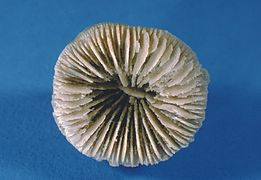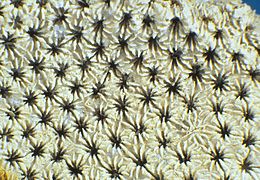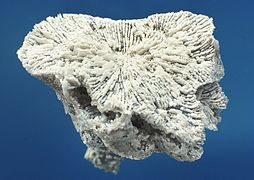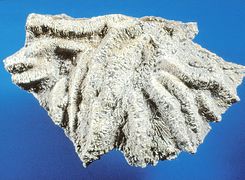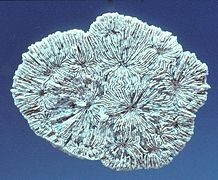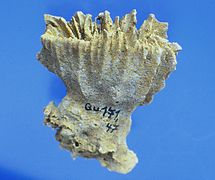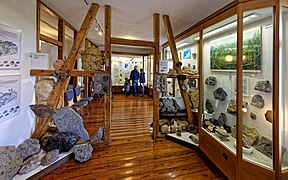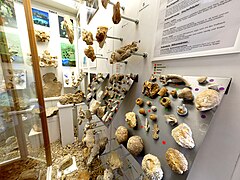Corals of the Swabian Alb
The limestone deposits of the corals of the Swabian Alb and other marine life form a low mountain range almost 200 km long, 35 to 40 km wide and up to 1000 m high in southern Germany.
Jurassic Corals
geology
The Swabian Alb is assigned to the Jura . It is a geological formation that began to form about 201.3 million years ago and ended 145 million years ago. Its limescale ended the Triassic Period , followed by the Cretaceous Period . In Germany, the southern German Jura includes the Rhine Valley, the Wutach region , the Swabian Alb and the Franconian Alb . The White Jurassic , about 161 to 150 million years ago, is important for fossil collectors because its coral formation contains the diverse stony corals .
In the generally warm climate of the Jurassic period, corals lived with many other marine life in the salt water of a shallow sea . With the lime sludge, the lime skeletons settled, which solidified to form a lime layer. This was pushed to the north with the layers later overlying during the continental drift (continental drift) and raised as a limestone slab. The sediments deposited above were removed again and the exposed layers form the Swabian Alb today.
From the history of research
The first evidence of the corals of the Swabian Alb come from Balthasar Ehrhart in 1748, where he describes the area northwest from Ulm to the Nördlinger Ries as Regio corallifera , coral- bearing region, in the first paleographic-facial map of southwest Germany . August Goldfuß described a large number of Jurassic corals in his Petrefacta Germaniae as early as 1826 to 1829 . In The corals of Nattheimer layers described by Ernst Becker and C. Milaschewitsch and illustrated them the coral fauna of the Ostalb 1875/76, to Friedrich August Quenstedt in Petre Fact customer in Germany the various works from 1852 to 1885. From the Swiss Jura added Frédéric-Louis Koby the Knowledge of Jurassic corals as well as D'Orbigny , Duncan , Etallon , Henri Milne Edwards and Jules Haime , Fleming , Fromentel , Lamarck , Münster, Phillips.
Systematics
Through the construction of the polyps , the corals are assigned to the six-pointed flower animals ( Hexacorallia ) and belong there to the order of the hard corals (Scleractinia). The further subordination with differentiations in families, genera and species has not been finally clarified in research. What is essential for these six-rayed Jurassic corals with their possible multiple septa numbers is the ability to build reefs together with other living beings through calcification .
Silicification
Organically separated lime is calcite (Ca [CO 3 ]), but harder and heavier than aragonite with a different crystal lattice. This often crystallized later into the more stable calcite state and can no longer be separated from the surrounding lime. Stromatolites helped to form lime. The reef debris at the edge of reefs is more silicified, in which other hard parts of sponges , sea urchins , sea lilies , mussels , snails , worm tubes , bryozoa and others can be seen. In a special way, however, this aragonite was also replaced by silica gels (SiO 2 ), which were converted into solid quartz (SiO 2 ), directly through penetrating pore water . Sometimes only the outer hard quartz layer is formed, while the inside is still made of lime. But there are also small rock crystals as well as calcite crystals.
References
Detailed lists of references can be found in Benz (1980) and Schweizer-Klemp (1985). Even if they seem out of date, freshly plowed fields offer new opportunities for discovery, as do fresh construction pits and road construction. The Sirchinger and Wittlinger deposits are near Urach and are no longer shown on this map. Stratigraphically they belong to Weißjura Zeta 1–3 (= Tithonium L, tiZ and tiH).
preparation
In fields, the weathered, silicified corals are mostly colored ocher yellow by iron oxides. Limestone lumps with gray structures, mostly as reef debris, reveal corals that can be etched free with hydrochloric acid (HCl). To do this, the pieces are covered with water in plastic containers. Then a small amount of hydrochloric acid is poured in each time. The carbon dioxide (CO 2 ) escapes in a bubbling manner , while the water slowly turns into a salt solution due to the calcium chloride (CaCl 2 ) that is formed. If further acid is added, this dampens the initially violent reaction (CaCl 2 is not toxic). Badly silicified areas can be covered with wax or Vaseline. Individual limescale can also be removed drop by drop with an infusion set.
determination
Determination via the reference works is not easy. The structures of the outer shell, septum structure and calyx centers have become essential in recent times. Outward forms recede. Older classifications are therefore repeatedly changed in new work. Some coral genera at Geyer and Benz were changed by Schweizer-Klemp and Lauxmann. New ones appear, but were always given the first name of the researcher, e.g. B. Montlivaltia (genus) ellipsocentra (species) (QUENSTEDT, 1881), as is customary in scientific work. The strong, knotty Thecosmilia trichotoma , which accounts for around 10% of all around 140 species, has been most successful in the Jurassic corals in calmer water .
On the Ostalb, the reef museum in Gerstetten offers insights into the rich reef fauna with very well-preserved individual examples, but also the museum in Nattheim . The Urweltmuseum Aalen , opened in 1977, is the largest municipal museum for geology and palaeontology in Baden-Württemberg. It also houses a special collection of Jurassic corals with their accompanying fauna.
literature
- Ernst Becker and C. Milaschewitsch: The corals of the Nattheim layers . In: Paläontografica 21, 1875/76.
- Friedrich August Quenstedt: Petrefctenkundekunde Germany vol. 6, tube and star corals 1881.
- Frédéric-Louis Koby: Monograph des polypiers jurassique de la Suisse , Mém. Soc. Paléont. Suisse, Vol. 7-16 a. 21 1880-1889.
- Otto Friedrich Geyer: The Upper Jurassic coral fauna of Württemberg , Palaeontogr. 104, Dept. A, pp. 121-222, 1954.
- Raymond C. Moore: Treatise on Invertebrate Paleontology, Part F: Coelenterata . Lawrence 1956.
- Arno Hermann Müller: Textbook of Paleozoology, Vol. II, Invertebrates Part 1 , Jena 1965.
- Helmut Schuhmacher: Coral Reefs , Munich 1976.
- Wolfram Benz: The corals of the upper white Jura of the Swabian Alb , Eglofs 1980.
- Manfred Grasshoff: Polyps and flower animals (Anthozoa) . In: Natur und Museum, Heft 1, 2 and 5, Frankfurt 1981.
- Wolfram Benz: "Flowers" of tropical seas - corals from the Malm . In: Mineralien-Magazin 4/1981, pp. 149–154.
- WS McKerrow (Ed.): (German) Palökologie , Stuttgart 1981.
- Schweizer-Klemp, Karin: Contributions to the coral fauna of the Upper White Jura in Württemberg with special consideration of the coral collection of the Natural History Museum of the City of Ulm . In: Mitt. D. Ver. f. Natural science u. Math. (Ulm / Donau, 1985), 34
- Edouard Lambelet: Corals in the coral oolite with special consideration of the genera , 1986.
- Wolfram Benz: The Swabian Alb - a land of tropical corals . In: Yearbook 1987/88. Local history and antiquity association Heidenheim ad Brenz. Pp. 9-27.
- Ursula Lauxmann: Revision of the Upper Jurassic corals of Württemberg , Palaeontogr. A vol. 219, Stuttgart 1991.
- Wolfram Benz: What coral collectors might be interested in . In: Fossilien , Goldschneck-Verlag, Korb 1996, pp. 173–181.
Web links
- What coral collectors might be interested in
- Corals in warm and cold periods - From the climate history of our earth
Individual evidence
- ↑ The Riffmuseum in Gerstetten
- ^ The Coral Museum in Nattheim
- ↑ The Urweltmuseum in Aalen ( Memento of the original dated February 7, 2017 in the Internet Archive ) Info: The archive link was inserted automatically and has not yet been checked. Please check the original and archive link according to the instructions and then remove this notice.










